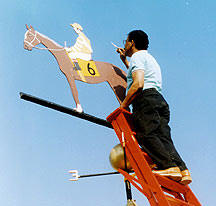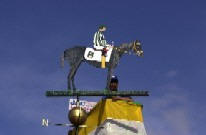Painting the Weather Vane
 The
Preakness requires a painter, tints of all colors and a ladder
to complete an annual tradition shortly after the horses cross
the finish line.
The
Preakness requires a painter, tints of all colors and a ladder
to complete an annual tradition shortly after the horses cross
the finish line.
As soon as the Preakness winner has been declared official, a
painter climbs a ladder to the top of a replica of the Old
Clubhouse cupola. He applies the colors
of the victorious owner's silks on the jockey and horse which
are part of the weather vane atop the infield structure. The
paint job remains until next year's
Preakness.
The practice started in 1909 at Pimlico when a horse and rider
weather vane sat at the top of the old Members' Clubhouse, which
was constructed when Pimlico
opened in 1870. The Victorian building was destroyed by fire in
June of 1966. A replica of the old building's cupola was built
to stand in the Preakness winner's
circle in the infield.
Originally, the ancient building had an arrow-shaped weather
vane, but in 1909 it was struck down by lightning. To replace
it, the Maryland Jockey Club
commissioned an ornamental iron worker to forge a vane in the
form of a horse and a rider. It was christened that spring by
coating it with the colors of the silks
borne by Effendi, winner of the 1909 Preakness.
 The
jockey on Effendi was Willie Doyle, who later served as one of
the best racing officials in America and whose ashes, upon his
death at the age of 67 in
The
jockey on Effendi was Willie Doyle, who later served as one of
the best racing officials in America and whose ashes, upon his
death at the age of 67 in
1950, were spread across the finish line of the track where he
scored his most famous victory.
In 1918, when the Preakness was run in two divisions, Jack Hare
Jr. winning one end and War Cloud the other, the winning colors
were changed after the first six months to give the victors
equal time in the year on the weather vane.
When the old Members' Clubhouse burned down the only thing saved
from the ruins was the iron weather vane. It is currently on
display at Pimlico's museum
exhibit, "Hoofbeats Through History."
In recent years, Tommy Ennis, a Charles Town, W. Va. sign
painter, had the honor of applying the winning colors on the
five foot wide aluminum model of horse
and rider weather vane on the replica of the old clubhouse.
Ennis retired in 1987. Michael Willinger of Sykesville, Md. took
over the job for the 1987 Preakness.
Lawrence Jones, who lives in the Pimlico neighborhood, has the
job now.
When Willinger had the assignment to paint the new colors on the
weather vane, he commented: "It is just the thrill of being able
to participate in a big local and
national event like this. Let's face it, its the only televised
sign painting job in the country."
In 2000, Jones was joined by a special partner to carry out the
tradition following Preakness 125. Renowned artist LeRoy Neiman
applied the winning colors
along with Jones following the classic race.

